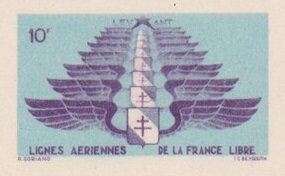Stamp: Wings and Cross of Lorraine (France - Free French Forces in the Levant 1942)
Wings and Cross of Lorraine (France - Free French Forces in the Levant 1942)
01 January (France - Free French Forces in the Levant ) within release FFL 1942 Issue goes into circulation Stamp Wings and Cross of Lorraine face value 10 French franc
| Stamp Wings and Cross of Lorraine in catalogues | |
|---|---|
| Stamp Number: | Sn: SY MC8b |
Stamp is square format.
Stamp from souvenir sheetAlso in the issue FFL 1942 Issue:
- Souvenir Sheet - Souvenir Sheet of 1942 Issue face value 35;
- Souvenir Sheet - Wings and Cross of Lorraine face value 16.50;
- Souvenir Sheet - Wings and Cross of Lorraine face value 16.50;
- Stamp - Wings and Cross of Lorraine face value 6.50;
- Stamp - Wings and Cross of Lorraine face value 10;
- Stamp - Wings and Cross of Lorraine face value 6.50;
- Stamp - Wings and Cross of Lorraine face value 10;
Stamp Wings and Cross of Lorraine it reflects the thematic directions:
An air force, also known in some countries as an aerospace force or air army, is in the broadest sense, the national military branch that primarily conducts aerial warfare. More specifically, it is the branch of a nation's armed services that is responsible for aerial warfare as distinct from an army, navy, or a marine corps. Typically, air forces are responsible for gaining control of the air, carrying out strategic and tactical bombing missions, and providing support to land and naval forces.
The term "air force" may also refer to a tactical air force or numbered air force, which is an operational formation either within a national air force or comprising several air components from allied nations. Air forces typically consist of a combination of fighters, bombers, helicopters, transport planes and other aircraft.
Many air forces are also responsible for operations of the military space, intercontinental ballistic missiles (ICBM), and communications equipment. Some air forces may command and control other air defence assets such as anti-aircraft artillery, surface-to-air missiles, or anti-ballistic missile warning networks and defensive systems. Some nations, principally Russia, the former Soviet Union and countries who modelled their militaries along Soviet lines, have or had an air defence force which is organizationally separate from their air force.
Peace-time/non-wartime activities of air forces may include air policing and air-sea rescue.
Air forces are not just composed of pilots, but also rely on a significant amount of support from other personnel to operate. Logistics, security, intelligence, special operations, cyber space support, maintenance, weapons loaders, and many other specialties are required by all air forces.
Aviation is the practical aspect or art of aeronautics, being the design, development, production, operation and use of aircraft, especially heavier than air aircraft. The word aviation was coined by French writer and former naval officer Gabriel La Landelle in 1863, from the verb avier (synonymous flying), itself derived from the Latin word avis ("bird") and the suffix -ation.
A cross is a geometrical figure consisting of two intersecting lines or bars, usually perpendicular to each other. The lines usually run vertically and horizontally. A cross of oblique lines, in the shape of the Latin letter X, is termed a saltire in heraldic terminology.
A symbol is a mark, sign, or word that indicates, signifies, or is understood as representing an idea, object, or relationship. Symbols allow people to go beyond what is known or seen by creating linkages between otherwise very different concepts and experiences. All communication (and data processing) is achieved through the use of symbols. Symbols take the form of words, sounds, gestures, ideas, or visual images and are used to convey other ideas and beliefs. For example, a red octagon is a common symbol for "STOP"; on maps, blue lines often represent rivers; and a red rose often symbolizes love and compassion. Numerals are symbols for numbers; letters of an alphabet may be symbols for certain phonemes; and personal names are symbols representing individuals.




